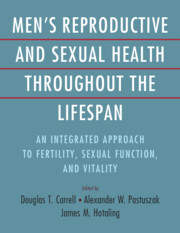 Men's Reproductive and Sexual Health Throughout the Lifespan
Men's Reproductive and Sexual Health Throughout the Lifespan Book contents
- Men’s Reproductive and Sexual Health throughout the Lifespan
- Men’s Reproductive and Sexual Health throughout the Lifespan
- Copyright page
- Contents
- Contributors
- Preface
- Section 1 An Introduction to Men’s Health Care
- Section 2 The Biology of Male Reproduction and Infertility
- Chapter 4 Current Understanding of the Physiology and Histology of Human Spermatogenesis
- Chapter 5 Male Reproductive Endocrinology
- Chapter 6 Sperm Chromatin Packaging and the Toroid Linker Model
- Chapter 7 Ejaculation and Sperm Transport
- Chapter 8 Genetic Aspects of Male Infertility
- Chapter 9 The Mechanistic and Predictive Utility of Sperm Epigenetics
- Chapter 10 Aging and Environmental Interactions with the Sperm Epigenome
- Chapter 11 The Effects of Aging on Male Fertility and the Health of Offspring
- Section 3 Clinical Evaluation and Treatment of Male Infertility
- Section 4 Laboratory Evaluation and Treatment of Male Infertility
- Section 5 Medical and Surgical Management of Issues of Male Health
- Index
- References
Chapter 4 - Current Understanding of the Physiology and Histology of Human Spermatogenesis
from Section 2 - The Biology of Male Reproduction and Infertility
Published online by Cambridge University Press: 06 December 2023
- Men’s Reproductive and Sexual Health throughout the Lifespan
- Men’s Reproductive and Sexual Health throughout the Lifespan
- Copyright page
- Contents
- Contributors
- Preface
- Section 1 An Introduction to Men’s Health Care
- Section 2 The Biology of Male Reproduction and Infertility
- Chapter 4 Current Understanding of the Physiology and Histology of Human Spermatogenesis
- Chapter 5 Male Reproductive Endocrinology
- Chapter 6 Sperm Chromatin Packaging and the Toroid Linker Model
- Chapter 7 Ejaculation and Sperm Transport
- Chapter 8 Genetic Aspects of Male Infertility
- Chapter 9 The Mechanistic and Predictive Utility of Sperm Epigenetics
- Chapter 10 Aging and Environmental Interactions with the Sperm Epigenome
- Chapter 11 The Effects of Aging on Male Fertility and the Health of Offspring
- Section 3 Clinical Evaluation and Treatment of Male Infertility
- Section 4 Laboratory Evaluation and Treatment of Male Infertility
- Section 5 Medical and Surgical Management of Issues of Male Health
- Index
- References
Summary
Spermatogenesis is a complex process that ensures daily production of mature male gametes. The differentiation of spermatogonia stem cells into spermatozoa requires the unfolding of several events that are highly regulated in time and space. During spermatogenesis, which takes place inside the seminiferous tubules, germ cells undergo profound morphological rearrangement as can be observed by classical histological analysis of human testis specimens. Spermatogenesis also brings about the dramatic rearrangement of genetic makeover of developing germ cells including homologous recombination and changes in the epigenetic landscape. In this chapter the different phases of human spermatogenesis and cell types involved are described with an emphasis on their morphological arrangements. In parallel, an update on novel findings concerning the cycle of the seminiferous epithelium, the kinetic of spermatogonial compartment, and the implications of single-cell transcriptome analysis of testicular cells will be provided.
- Type
- Chapter
- Information
- Men's Reproductive and Sexual Health Throughout the LifespanAn Integrated Approach to Fertility, Sexual Function, and Vitality, pp. 23 - 33Publisher: Cambridge University PressPrint publication year: 2023


